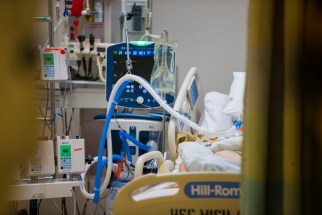Hospitalization numbers keep restriction rollback in check
Read this article for free:
or
Already have an account? Log in here »
To continue reading, please subscribe:
Monthly Digital Subscription
$0 for the first 4 weeks*
- Enjoy unlimited reading on winnipegfreepress.com
- Read the E-Edition, our digital replica newspaper
- Access News Break, our award-winning app
- Play interactive puzzles
*No charge for 4 weeks then price increases to the regular rate of $19.00 plus GST every four weeks. Offer available to new and qualified returning subscribers only. Cancel any time.
Monthly Digital Subscription
$4.75/week*
- Enjoy unlimited reading on winnipegfreepress.com
- Read the E-Edition, our digital replica newspaper
- Access News Break, our award-winning app
- Play interactive puzzles
*Billed as $19 plus GST every four weeks. Cancel any time.
To continue reading, please subscribe:
Add Free Press access to your Brandon Sun subscription for only an additional
$1 for the first 4 weeks*
*Your next subscription payment will increase by $1.00 and you will be charged $16.99 plus GST for four weeks. After four weeks, your payment will increase to $23.99 plus GST every four weeks.
Read unlimited articles for free today:
or
Already have an account? Log in here »
Hey there, time traveller!
This article was published 09/02/2021 (1768 days ago), so information in it may no longer be current.
There are a few reasons why the province is only making minor changes to its COVID-19 pandemic restrictions this week. A key factor: hospitalization numbers are no longer on the decline.
The number of patients hospitalized with COVID-19 has dropped since December, when there were more than 300 — including more than 40 in intensive care — on some days.
The numbers fell throughout the month of January, hitting a low of 254 on Feb. 2. (That includes patients with active COVID-19 and those who have recovered, but still require medical care.)

Case counts and the test positivity rate (for both Winnipeg and provincewide) have been trending lower for weeks. However, the number of COVID-19 patients in hospital has remained steady since the end of January; on Tuesday, there were 266, including 33 in ICUs.
Hospitalizations are an important surveillance tool for public health. Officials know that a certain percentage of people who contract COVID-19 will become sick enough to require hospital care.
It acts as a check to daily case counts, which can be skewed by the public’s willingness to get tested.
The number of patients in hospital tends to lag behind daily reports of new cases; when case counts fall, there is usually a drop in hospitalizations about two weeks later. But not recently.
There may be a few reasons for that, including longer hospital stays for some. Still, it doesn’t change the fact there are relatively high numbers of patients in hospital while overall cases are falling.
According to the province’s weekly COVID-19 surveillance data, the number of new hospital admissions remained steady throughout January.
It peaked in late November, when there were more than 200 per week. After falling below 100 per week in early January, it has remained between 63 and 87 throughout the month. It increased to 75 the last week of January, from 63 the previous week.
Public health officials don’t use a single indicator to make decisions on pandemic restrictions. They consider a wide range of data, and use their best judgment to assess the epidemiological, economic and social impacts of their decisions.
The changes approved this week struck a reasonable balance between protecting Manitobans from the SARS-CoV-2 virus and allowing more freedom in society.
The province couldn’t go much further without jeopardizing another surge, especially with the new U.K. variant being confirmed Monday in Manitoba. It was particularly important to maintain restrictions on household gatherings, where transmission among people indoors for prolonged periods (without face masks) poses one of the greatest risks.
.jpg?w=1000)
As usual, not everyone will be happy. We will hear the inevitable complaints about why one facility can open and not another, even though both can seemingly operate with the same level of safety.
The answer is simple: the more public places that open, regardless of risk, the higher the number of total transmissions.
It’s unlikely the province will loosen restrictions much further three weeks from Friday (when public health orders expire) unless hospitalization numbers start to fall again. Those figures are not only important for surveillance purposes, they measure hospital capacity.
One of the main goals during the pandemic is to ensure hospital staff have the ability to treat patients, including those not infected with the virus. When hospitals were admitting more than 200 patients a week with COVID-19, medical wards were on the verge of collapse. Thousands of elective surgeries had to be cancelled to free up staff.
With fewer than 100 new patients admitted to hospital per week in January, that pressure has been alleviated, but only marginally. The numbers still have to come down before restrictions are eased further.
The good news: Manitobans have direct control over that.
tom.brodbeck@freepress.mb.ca

Tom has been covering Manitoba politics since the early 1990s and joined the Winnipeg Free Press news team in 2019.
Our newsroom depends on a growing audience of readers to power our journalism. If you are not a paid reader, please consider becoming a subscriber.
Our newsroom depends on its audience of readers to power our journalism. Thank you for your support.










